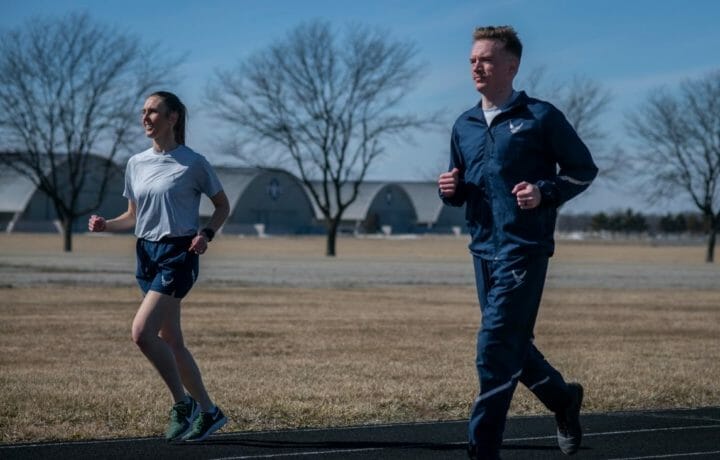In January 2023, the Air Force announced it would once again start using height-to-weight ratios to measure troops’ fitness. The plan was for the new program to begin on April 1, 2023, but that deadline has been extended to at least the Fall, but it could be longer.
Tape Test Removed
The abdominal circumference test known as the “tape test” was removed from the Air Force-specific Physical Fitness Assessment (PFA) in 2020 because there were worries some troops were starving themselves to help meet standards. This new test still measures a troop’s waist but the measurement is at a new location and accounts for height that was not considered in the “tape test.”
Both the Air and Space Forces released a new Waist-to-Height Ratio Body Composition Program (BCP) policy in January. The BCP is a separate and distinct program not part of the standard PFA.
“The goal of the new program is to empower Airmen to take charge of their health and fitness through lifestyle enhancement to optimize readiness,” said Lt. Gen. Caroline Miller, deputy chief of staff for Manpower, Personnel, and Service.
A new standard
“Above all, our priority is to shift our Guardians’ mindset with regard to their health,” said Katharine Kelley, deputy chief of Space Operations for Human Capital. “We hope the new body composition program and associated holistic health educational resources will inspire our members to move away from an episodic fitness mentality to putting their health first every day.”
The new standard set to go into effect April 1 has been delayed at least six months because of a delay in writing the new instructions according to Air Force spokesperson Master Sgt. Deana Heitzman, April 5th.
The instruction is expected to be published this summer, but no official date has been released by the Air Force.
Once the instruction is released it is expected to go into effect 180 days after publication.
The WHtR is built different
According to the Air Force, the new Waist-to-Height ratio (WHtR) is different from the unpopular “tape test” removed from the PFA in 2020. Instead of grading troops on their waist circumference alone, the WHtR combines both height and waist measurements into the calculation.
The WHtR is also different because of where it defines the waist to be. Instead of being measured at the top of the hip bone, it measures the waist at the midpoint between the lowest rib and the top of the hip bone, normally the narrowest portion of the abdomen. The waist circumference is then divided by a member’s height giving you a score.
Airmen or Guardians with a score lower than 0.55 will meet standards and those with scores above 0.55 will not meet standards.
Airmen who do not meet standards will be enrolled into an informal, self-directed Body Composition Improvement Program for 12 months and referred to their medical treatment facility for a medical evaluation and assent.
Guardians will be referred to Guardian Resilience Teams to provide care and resources to assist Guardians who do not meet standards.
12 Months to Improve
At the end of twelve months, Airmen and Guardians will be reassessed. If they do not meet standards they will be considered a failure to meet standards and will require enrollment in a formal self-directed BCIP that may result in consideration for administrative actions, including separation for continued failures to meet standards.
To help meet recruitment goals, the Air Force loosened its rules on body fat for recruits. Now those same recruits will need to meet the new WHtR standard when it rolls out.




